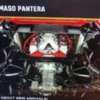For looks it is not a disappointment. Don't expect anything significant as far as added performance unless you are going to regularly run over 8,000 rpm, because that is what those manifolds are designed for.
They are essentially single 4v tunnel ram manifolds.
I have not run the Parker but I did run the Ford Motorsport A341. It is VERY similar.
Considering that it's intent was superior very high rpm performance, it works well.
It is about the same overall height as the Parker. As such, it is made with a level carb pad, not cut 17° like would be used in an American V-8. Installed that way in the Pantera, it looked silly so I had it milled like a normal American V8 would have been, and removed the center section to the screen for clearances.
If you drive the car in cold weather at all, expect frost on the runners and the carb. In fact under around 40° F, it will tend to ice up the carb. It won't get any engine heat as the runners of the manifold will act as a heat sink.
Engine builders will also tell you that to get the maximum power out of them that you need to do flow bench work on the plenum and runners.
Also if you buy one, make sure they are for the heads you are using on the car. The Australian "Clevelands" tend to be designed for the 2v heads and the runners for those are significantly different then the 4v heads.
Good luck! Looks great!



